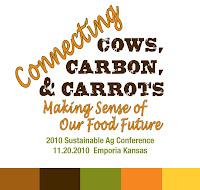Emporia, Ks.- Climate change is far less a threat to ecosystems than it is to the humans who rely upon them, according to USDA Natural Resource and Conservation Service rangeland ecologist Joel Brown.
 |
| Download Joel Brown's conference keynote presentation here. |
“Climate change will come to dominate our lives,” the researcher at USDA’s Jornada Experimental Range in New Mexico said. “We live in a changing climate. We shouldn’t be arguing about that. It’s changing and it will always be changing.”
Citing the Dust Bowl era as an example, Brown pointed out that nature adapts and returns to productivity after dramatic climate events. The more important question is how well people can adapt to changes in the weather?
Although steps to mitigate climate change, such as reducing greenhouse gas emissions, garner most of the public attention, Brown believes that learning to adapt is a more productive course. “Ninety percent of our response to climate change should be adapting to it,” he said. Despite mitigation efforts, greenhouse gas emissions in the U.S. continue to increase to about 1 percent per year as nearly 7 billion tons rise into the atmosphere.
 Agriculture, he noted, is responsible for only 6-7 percent of that total. Even if the industry successfully employed the management and technology to reduce its emissions by 20-30 percent, that fraction of a fraction would have little impact. “We’re a small player in that market,” he said. “The bottom line is that we’re not going to be able to have a huge impact on climate change.”
Agriculture, he noted, is responsible for only 6-7 percent of that total. Even if the industry successfully employed the management and technology to reduce its emissions by 20-30 percent, that fraction of a fraction would have little impact. “We’re a small player in that market,” he said. “The bottom line is that we’re not going to be able to have a huge impact on climate change.”While the U.S. has reduced emissions per dollar of GNP (Gross National Product), growth in both population and production more than offsets the effect of new conservation technologies and the rate of growth in developing nations will keep global greenhouse emissions on the rise.
Although Brown is in favor of taking steps to reduce emissions, the public focus should be on facing a stark reality. “We have to be realistic about mitigation,” he asserted. “It is an increasingly unlikely option.”
The impact of climate change will vary widely, said Brown who began his career as a District Conservationist in Kansas. A small rise in sea level would be catastrophic in Fiji, for example, but would have little direct impact in Kansas. Still, even Kansas farmers are facing — and will continue to face — changing weather. “The frost-free season length has gone up nine to 10 days since 1970,” he observed. “That’s good if you’re feeding hay to cattle in the winter but what about the effect on pathogens and pests?”
Crops and forage production, Brown said, is more highly variable with more volatile weather patterns and there is a direct climate change impact on both plants and animals. Higher carbon dioxide levels can increase plant growth, although not necessarily grain yields. From a stockman’s perspective forage quantity increases with more CO2 in the atmosphere but quality and digestibility decrease. “In the future, a higher CO2 world is destined to reduce individual animal performance,” Brown said.
 |
| Click to enlarge. |
long-term average — some far more dramatic than others.”
The evidence of a warming climate is indisputable, Brown said. A dramatically shrinking ice mass in Greenland and Antarctica and a rise in sea level are measured facts, not conjecture, he said. Wide variations in temperature show up locally and regionally but, on a global basis, the trend is clear.
Information is the key to dealing with climate change for agriculture, Brown said, noting that extension and USDA will be more important than ever in providing information about how management can be adapted. “We live in a changing climate,” the rangeland ecologist concluded. “It has always changed and always will but that change is probably going to accelerate. And we’re going to have to learn to adapt.”
The Connecting Cows, Carbon & Carrots: Making Sense of Our Food Future conference was presented by the Kansas Rural Center and cosponsored by the Kansas Center for Sustainable Agriculture and Alternative Crops.
In addition to the keynoter, eighteen workshops featured presentations on a wide range of topics including trends in production and marketing of grass fed beef, opportunities in local and regional food in Kansas, cover crops, specialty crop production, hoop house production, school and community gardens, food policy councils, and the 2012 farm bill. Copies of presentations are available online at KRC’s website at www.kansasruralcenter.org.

No comments:
Post a Comment